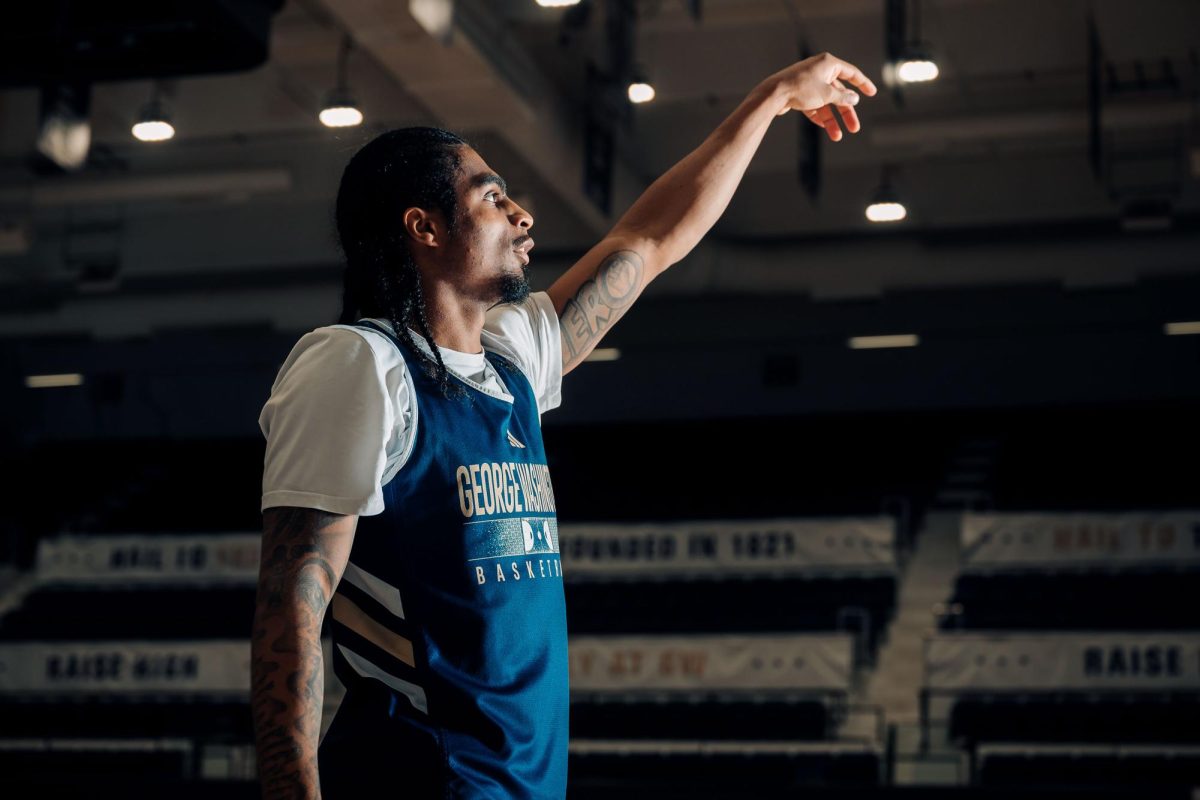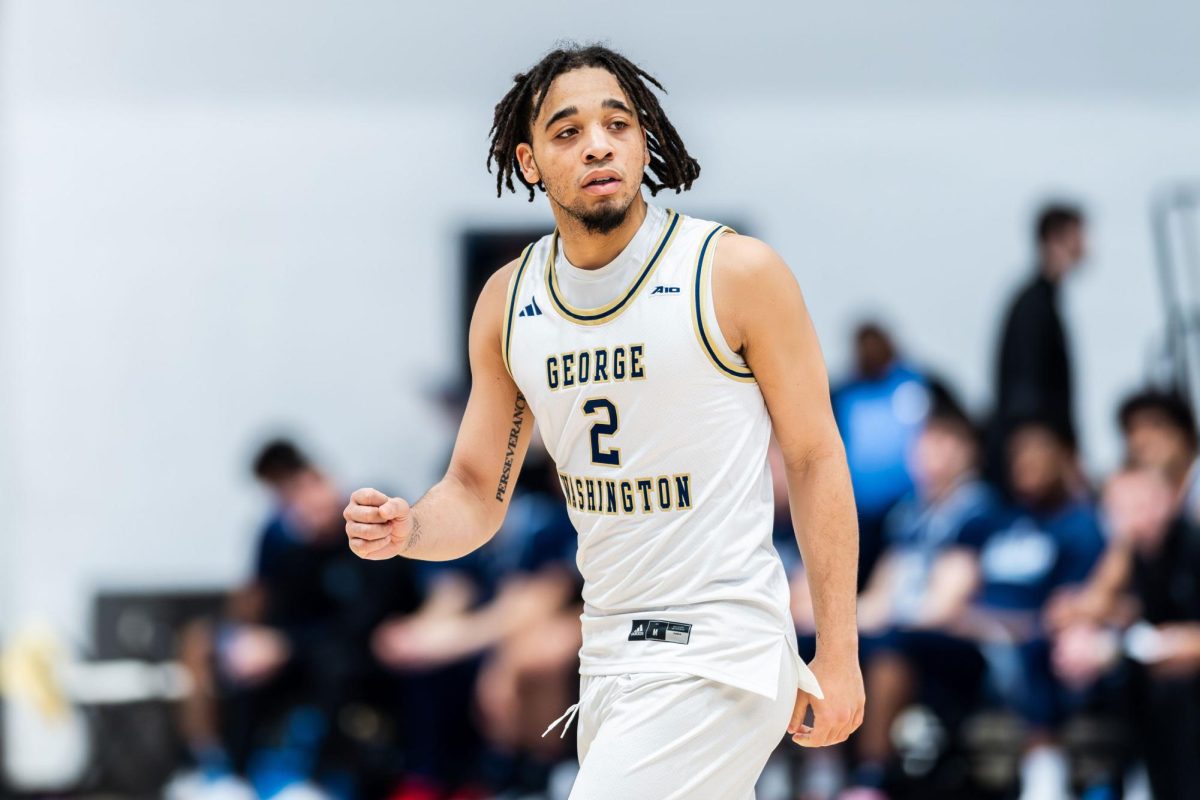
BROOKLYN, N.Y. – Patricio Garino caught the ball and released. Swish. A minute later. Another one.
Highfives followed as he ran back, through mobbing teammates, to defend.
The GW bench was hyped. The Atlantic 10’s three-point shooting leader had put the Colonials back in the game, up four with eight minutes to play. Back in the game with what they had lived off of all first half, shooting a sensational 11-of-16 from beyond the arc.
“Those flurries, to be honest with you, felt like a street fight,” Saint Joe’s head coach Phil Martelli said. “And if you’ve ever been in a street fight, you don’t know where the punches are coming from and you’re just trying to cover up.”
They were back in the game off of what they used to advance to the quarterfinals of the A-10 Championship.
The three-pointer promised potential – potential to win against No. 4 seed Saint Joe’s at the Barclays Center, potential to win this one game, which head coach Mike Lonergan thought could lock up a bid into the NCAA Tournament and provide the potential to make a deep run.
But too many three-pointers is not necessarily a good thing.
Throughout the 2015-16 campaign, GW showed flashes of fervor from behind the arc.

The Colonials were a team that shot an average 36.2 percent on three-pointers heading into the game. They were a team with three shooters who shot at better than a 40 percent clip on the season, and a fourth in junior Tyler Cavanaugh who shot 39.2 percent. The Colonials were fourth in the conference in three-point percentage headed into the tournament.
In its last game, against Saint Louis, GW won 73-65, shooting 55.6 percent from three. Out of the team’s total points scored, 41.1 percent of them came via the three. Rarely do the Colonials find success when they find that high clip of their points from threes.
The breaking point heading into the day’s quarterfinals was 36 percent.
When GW relied on three-pointers for more than 36 percent of its points, they generally lost. In general, the more points the Colonials scored off three-point baskets, the less likely they were to win.
But it was hard to argue with the Colonials’ strategy with the team heading into the locker room up 49-35 at halftime on the higher-seeded Saint Joe’s team after nailing 11 threes and finding 67 percent of their team points off the golden shot.
“I just said, ‘Hey, share the ball.’ ‘If you’re open, shoot it.’,” head coach Mike Lonergan said. “Even Anthony Swan when he shot that three, I thought it was a great look for him. They were wide-open threes. Our threes were great threes.”
Saint Joe’s head coach Phil Martelli felt similarly.
“Call it the way it is: That one three by Swan hit the rim four times and went in, so some days you wonder,” Martelli said. “Second half it didn’t go that way.”
In the second half, GW went cold – aside from those two seemingly-momentum changing threes from Garino. They shot 4-of-15, 26.7 percent. Still, the total points scored off of the three accounted for 38 percent of their team points. Statistically, GW typically does not win when they score in this fashion.
There are plenty of other reasons to point to for the loss, which will likely condemn the Colonials to playing in the NIT this postseason.
One place they will look to find more of their success will be from the free throw line. A place that was typically a safe haven this year for the Colonials, who in years past found issues at that stripe.
Naturally, when GW scores more of its points off of the three-pointer, the team tends to shoot less free throws. When more and more points are coming via triples, that means less and less, proportionally speaking, are coming via strong inside play and getting to the foul line – GW’s bread and butter this season.
Ultimately the Colonials found difficulty against Saint Joe’s once foul trouble hit them. Lonergan elected to bring Cavanaugh into the game with four fouls and six minutes to play, up one point. Cavanaugh fouled out 49 seconds later, with 13 points, four rebounds and two threes.
Saint Joe’s also changed their team defense in the second half, particularly down the stretch, to prevent GW from having open looks. They switched to a “makes-and-misses zone,” which frustrated senior Kevin Larsen and found GW attempting to unsuccessfully drive the lane.
“The zone was effective for us in D.C.,” Martello said. “And it was certainly effective here.”
The excess in three-pointers was not the only reason for GW’s loss – Saint Joe’s shot 57.4 percent from the field while GW shot 32.4 percent in the second half – but it helps explain how the Colonials faltered down the stretch. Scoring is never bad, but for every three-pointer taken, a possession went by when the Colonials didn’t pound the ball inside. The three was not GW’s shot this year, and, by the numbers, relying on it meant the Colonials were getting away from the shots that were.







